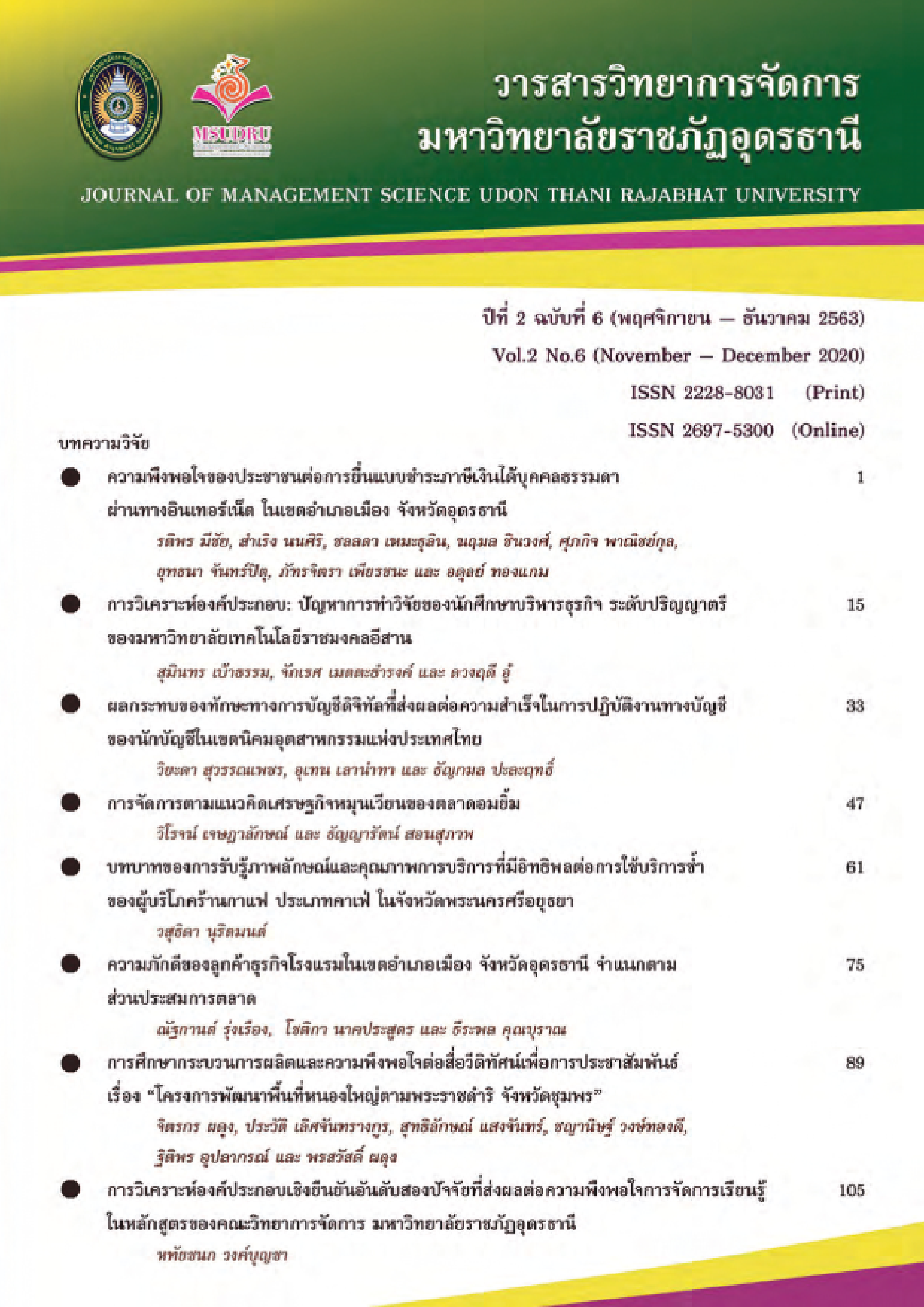การจัดการตามแนวคิดเศรษฐกิจหมุนเวียนของตลาดอมยิ้ม
Main Article Content
บทคัดย่อ
งานวิจัยนี้มีวัตถุประสงค์คือ 1) เพื่อศึกษาบริบทของตลาดอมยิ้ม ตำบลจอมบึง อำเภอจอมบึง จังหวัดราชบุรี 2) เพื่อศึกษาการจัดการเชิงกลยุทธ์ตามแนวคิดเศรษฐกิจหมุนเวียนของตลาดอมยิ้ม การวิจัยนี้ใช้วิธีการดำเนินการวิจัยเชิงคุณภาพ (Qualitative research) ประกอบด้วยการสัมภาษณ์เชิงลึก และการสัมภาษณ์กลุ่มเฉพาะ ผู้ให้ข้อมูลแบ่งเป็น 2 กลุ่ม คือ ผู้ประชาสัมพันธ์ตลาดอมยิ้ม และผู้ค้าในตลาดอมยิ้ม วิจัยนี้ใช้วิธีการสุ่มตัวอย่างแบบเจาะจง (Purposive sampling) ในการเลือกผู้ให้ข้อมูลและใช้แบบสัมภาษณ์ในการสัมภาษณ์เชิงลึก ข้อมูลจากการสัมภาษณ์จะนำมาวิเคราะห์ด้วยวิธีการวิเคราะห์เชิงเนื้อหา (Content Analysis) ผลการวิจัยพบว่า 1) ตลาดอมยิ้มเป็นตลาดชุมชนที่เกิดจากการร่วมมือกันระหว่างวัดวาปีสุทธาวาส มหาวิทยาลัยราชภัฏหมู่บ้านจอมบึง และคนในชุมชน เพื่อจัดสรรพื้นที่ภายในวัดให้เกิดประโยชน์ ส่งเสริมเศรษฐกิจชุมชน และให้คนในชุมชนมีส่วนร่วมกับกิจกรรมต่างๆ ภายในชุมชน โดยสินค้าภายในตลาดอมยิ้มเป็นสินค้าชุมชน อาหารทั่วไป และสินค้าจิปาถะเป็นหลัก ซึ่งให้บริการในเสาร์ และวันอาทิตย์เท่านั้น 2) การจัดการเชิงกลยุทธ์ตามแนวคิดเศรษฐกิจหมุนเวียน ตลาดอมยิ้มมีการจัดตั้งนโยบายภายในตลาด โดยกำหนดให้ผู้ค้าลดการใช้ถุงพลาสติกเพื่อต้องการทำตลาดอมยิ้มให้เป็นตลาดที่ปราศจากขยะพลาสติก โดยนำแนวคิดเศรษฐกิจหมุนเวียนมาประยุกต์ใช้ คือการนำวัสดุเหลือใช้หรือวัสดุที่เป็นมิตรต่อธรรมชาติมาออกแบบหรือประยุกต์ใช้เป็นบรรจุภัณฑ์ เช่น ใบตอง นิตยสารเก่าทำเป็นถุงกระดาษ เป็นต้น เพื่อลดขยะและลดการเกิดผลกระทบต่อสิ่งแวดล้อม ลดภาวะโลกร้อน และลดต้นทุนในการซื้อบรรจุภัณฑ์ ซึ่งจากงานวิจัยผู้จัดการตลาดอมยิ้มสามารถนำข้อมูลไปประยุกต์ใช้เพื่อปรับปรุงหรือพัฒนาในด้านการจัดการตามแนวคิดเศรษฐกิจหมุนเวียนต่างๆ ของตลาดให้มีประสิทธิภาพมากยิ่งขึ้นได้
Article Details

อนุญาตภายใต้เงื่อนไข Creative Commons Attribution-NonCommercial-NoDerivatives 4.0 International License.
บทความที่ได้รับการตีพิมพ์เป็นลิขสิทธิ์ของคณะวิทยาการจัดการ มหาวิทยาลัยราชภัฏอุดรธานี
ข้อความที่ปรากฏในบทความแต่ละเรื่องในวารสารวิชาการเล่มนี้
ไม่ใช่ความคิดเห็นและความรับผิดชอบของผู้จัดทำ บรรณาธิการ กองบรรณาธิการ และคณะวิทยาการจัดการ มหาวิทยาลัยราชภัฏอุดรธานี ความรับผิดชอบด้านเนื้อหาและการตรวจร่างบทความแต่ละเรื่องเป็นความคิดเห็นของผู้เขียนบทความแต่ละท่าน
เอกสารอ้างอิง
ดร.วิทยา พัฒนเมธาดา. (2560).การจัดการเชิงกลยุทธ์ (Strategic Management). สืบค้นเมื่อ 19 เมษายน
, จาก http://www.kansuksa.com/31/
ตลาด.(เล่มที่ 28). สืบค้น 20 มีนาคม 2563, จาก http://saranukromthai.or.th/sub/book/book.php?book=28&chap=3&page=chap3.htm&fbclid=IwAR01QVn56DF-icWRk3RPMY_aUlaotk3hAn39RmU870bLricbLLdqZIfVjCA
ปพนวัฒน์ ฉินธนทรัพย์, ดวงรัตน์ โกยกิจเจริญ และนิศศา ศิลปะเสรฐ. (2550). กลยุทธ์การสร้างความแตกต่างของผลิตภัณฑ์กรณีศึกษา ร้านของฝากในจังหวัดภูเก็ต. สืบค้น 13 พฤษภาคม 2563, จาก http://human.skru.ac.th/husoconference/conf/P39.pdf
พชร สูงเด่น. (11 ตุลาคม 2562). ‘ตลาดชุมชน’ เป็นกระจกสะท้อนคุณภาพชีวิตและประตูต้อนรับผู้มาเยือน. สืบค้น 20 มีนาคม 2563, จาก https://adaybulletin.com/life-citytales-public-markets/42305
ภัทราพร แย้มละออ. (17 มิถุนายน 2561). Circular Economy เศรษฐกิจหมุนเวียนโอกาสใหม่ของธุรกิจเพื่อความยั่งยืน. สืบค้น 15 มีนาคม 2563, จาก http://www.allaroundplastics.com/article/sustainability/1898?fbclid=IwAR3HIc46QCE485xgRGLFM7CK-N56wgqhmm2CrmNbrMWb-jJYRXn16XItOlo
เมษยา บุญสีลา และวงจันทร์ พูลเพิ่ม. (2562). การแปรรูปผลิตภัณฑ์จากขยะมูลฝอยสู่การพัฒนาเป็นกลุ่มอาชีพในชุมชน. สืบค้นเมื่อ 21 สิงหาคม 2563, จาก http://blog.bru.ac.th/wp-content/uploads/2019/09/บทความวิจัยการแปรรูปผลิตภัณฑ์จากขยะมูลฝอยสู่การพัฒนาเป็นกลุ่มอาชีพในชุมชน.pdf
วิถีชุมชน สร้างเศรษฐกิจฐานราก : ตลาดชุมชน. (มีนาคม 2560). สืบค้นเมื่อ 20 มีนาคม 2563, จาก http://www.thaihealthycommunity.org/wp-content/uploads/2017/03/02_%E0%B8%95%E0%B8%A5%E0%B8%B2%E0%B8%94%E0%B8%8A%E0%B8%B8%E0%B8%A1%E0%B8%8A%E0%B8%99.pdf
วิมลมาศ. (2557). สร้างความแตกต่างให้กับสินค้า. สืบค้นเมื่อ 13 พฤษภาคม 2563, จาก https://th.jobsdb.com/th-th/articles/%E0%B8%AA%E0%B8%A3%E0%B9%89%E0%B8%B2%E0%B8%87%E0%B9%82%E0%B8%AD%E0%B8%81%E0%B8%B2%E0%B8%AA%E0%B9%83%E0%B8%99%E0%B8%81%E0%B8%B2%E0%B8%A3%E0%B8%82%E0%B8%B2%E0%B8%A2/
ศรีสุดา ลีลาสุวัฒน์, พสชนันท์ บุญช่วย และณัฐปภัสร์ เทียนจันทร์. (2558). แนวทางการพัฒนามาการตลาด OTOP สู่สากล อำเภอสามพราน จังหวัดนครปฐม. สืบค้น 10 เมษายน 2563, จาก http://korat.cdd.go.th/wp-content/uploads/sites/22/2017/06/Fulltext.pdf
อิศราวดี ชำนาญกิจ. (2555). การจัดการเชิงกลยุทธ์ (Strategic Management). สืบค้นเมื่อ 19 เมษายน 2563, จาก https://www.gotoknow.org/posts/297090
อำพัน ศิริสมและดิฐา แสงวัฒนะชัย. (2561). การศึกษารูปแบบตลาดนัดชุมชนตำบลนาโพธิ์ อ.กุดรัง จ.มหาสารคาม. สืบค้นเมื่อ 14 เมษายน 2563, จาก http://www.journal.msu.ac.th/upload/articles/article2179_11648.pdf
SCG. (2563). SCG Circular Way หมุนเวียนกลับมาใช้ให้คุ้มค่า. สืบค้น 21 สิงหาคม 2563, จาก https://www.scg.com/sustainability/circular-economy/
SME Thailand Club. (2560). 3 เหตุผลหลักๆ ทำให้ธุรกิจคุณขยายตัวไม่ได้. สืบค้น 25 เมษายน 2563, จาก https://www.smethailandclub.com/entrepreneur-2418-id.html


